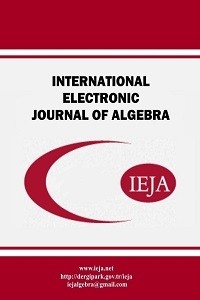When do quasi-cyclic codes have $\mathbb F_{q^l}$-linear image?
When do quasi-cyclic codes have $\mathbb F_{q^l}$-linear image?
Cyclic code, quasi-cyclic code additive cyclic code, linear code,
___
- J. Bierbrauer, The theory of cyclic codes and a generalization to additive codes, Des.Codes Cryptogr., 25(2) (2002), 189-206.
- C. Güneri, F. Özdemir and P. Sole, On the additive cyclic structure of quasi-cycliccodes, Discrete. Math., 341(10) (2018), 2735-2741.
- S. Ling and C. Xing, Coding Theory, Cambridge University Press, 2004.
- M. Shi, J. Tang, M. Ge, L. Sok and P. Sole, A special class ofquasi-cyclic codes, Bull. Aust. Math. Soc., 96(3) (2017), 513-518.
- M. Shi, R. Wu and P. Sole, Long cyclic codes are good, arXiv: 1709.09865v3 [cs.IT], 17 oct 2017, 1-5.
- ISSN: 1306-6048
- Yayın Aralığı: Yılda 2 Sayı
- Başlangıç: 2007
- Yayıncı: Abdullah HARMANCI
Rota---Baxter operators on $Cur(sl_2(\mathbb{C}))$
Vsevolod GUBAREV, Roman KOZLOV
On modules with chain condition on non-small submodules
Avanish Kumar CHATURVEDI, Nirbhay KUMAR
Cayley subspace sum graph of vector spaces
G. KALAIMURUGAN, S. GOPINATH, T. TAMIZH CHELVAM
Classification of three-dimensional isopotent algebras
On vertex decomposability and regularity of graphs
Amir MAFI, Dler NADERI, Parasto SOUFIVAND
Planar index and outerplanar index of zero-divisor graphs of commutative rings without identity
G. KALAIMURUGAN, P. VIGNESH, M. AFKHAMI, Z. BARATI
On some ideal structure of Leavitt path algebras with coefficients in integral domains
A little mistake in a paper by Bob Gilmer on rngs
Alberto FACCHINI, Jennifer PAROLIN
The dual of infinitesimal unitary Hopf algebras and planar rooted forests
Xiaomeng WANG, Loic FOISSY, Xing GAO
